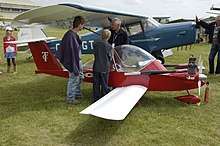Colomban Cri-cri
The Colomban Cri-Cri is the smallest twin-engined manned aircraft in the world, designed in the early 1970s by French aeronautical engineer Michel Colomban.
| Cri-Cri | |
|---|---|
 | |
| French-built homebuilt Cri-Cri at Airexpo 2007 | |
| Role | Homebuilt recreational aircraft |
| Designer | Michel Colomban |
| Introduction | 1973 |
| Status | In civilian use |

The name Cri-Cri comes from the nickname of Christine, one of Colomban's daughters.[1][2][3] 'Cri-cri' 'or 'cricri' is also the French term for the sound of a cricket or a cicada, or an informal name for the insects themselves,[4][5] but it is unclear if this double meaning was intended by Colomban himself.
Design and development
The Cri-Cri features a cantilever low-wing, a single-seat enclosed cockpit under a bubble canopy, fixed tricycle landing gear and twin engines mounted on pylons to the nose of the aircraft in tractor configuration. The aircraft is made from aluminum sheet glued to Klegecell foam. Its 4.9 m (16.1 ft) span wing employs a Wortmann 21.7% mod airfoil, and has an area of 3.1 m2 (33 sq ft). The aircraft is also capable of aerobatics within the limitations of twin-engined aircraft.[6][7][8]
Variants
- MC-12 Cri-Cri
- Model with a cruising speed of 185 km/h (100 knots, or 114.9 miles per hour) and range of 500 km (310.6 statute miles, 270 nautical miles).
- MC-15 Cri-Cri
- Model powered by two JPX PUL 212 15 horsepower (11 kW) engines.[6]
- MC-15 Cri-Cri Jet
- Model powered by two PBS VB TJ20 210 newtons (47 lbf) turbojet engines.[9]
Operational use
As with any homebuilt aircraft, the existing Cri-Cri planes have often been modified by their builders, departing from the original design to a varying degree, resulting in varying performance. Most versions can climb with one engine inoperative.[10]
In June 2010, EADS partnered with Aero Composites Saintonge and the Greencri-cri Association to present an electric-powered Cri-Cri at the Green Aviation Show in Le Bourget. The modified airframe with composite components can fly for 30 minutes at 110 km/h. The aircraft uses four brushless electric motors with counter-rotating propellers, which makes the aircraft one of the world's smallest four-engine aircraft.[11]
On September 5, 2010 Electravia accomplished a world record speed of 262 km/h (162.33 mph) for a lithium polymer-powered aircraft using a Cri-Cri with two electric motors (each producing 25 hp) during the attempt. The company claimed engine and cooling drag reductions of 46 percent versus the conventional combustion engine arrangement.[12]
On 9 July 2015 the electric-powered Electravia version of the design flew across the English Channel hours before the Airbus E-Fan,[13] becoming the third electric aircraft to do so. It was pulled aloft by another aircraft and did not take off on its own.[14][15] The first was the MacCready Solar Challenger in 1981[16] and the second used electric motors powered by hydrogen.[17]
Specifications (MC 15)
Data from Michel Colomban[18]
General characteristics
- Crew: one
- Length: 3.9 m (12 ft 10 in)
- Wingspan: 4.9 m (16 ft 1 in)
- Wing area: 3.1 m2 (33 sq ft)
- Airfoil: Wortmann 21.7
- Empty weight: 78 kg (172 lb)
- Max takeoff weight: 170 kg (375 lb)
- Powerplant: 2 × JPX PUL 212 single-cylinder piston engines, 11 kW (15 hp) each
- Propellers: 2-bladed
Performance
- Maximum speed: 220 km/h (140 mph, 120 kn)
- Cruise speed: 190 km/h (120 mph, 100 kn)
- Range: 460 km (290 mi, 250 nmi)
- Service ceiling: 3,700 m (12,100 ft)
- Rate of climb: 6.6 m/s (1,300 ft/min)
- Wing loading: 55 kg/m2 (11 lb/sq ft)
See also
Aircraft of comparable role, configuration and era
References
- "MC-15 Cri-Cri". free.fr. Retrieved 29 January 2017.
- "Le plus petit avion du monde – Cricri, un moustique sur l'aile des géants". parismatch.com. Retrieved 15 March 2017.
- "Le MC-15 "Cri-cri" – Ailes Anciennes de Haute-Savoie". ailesahs.com. Retrieved 15 March 2017.
- "CRICRI : Définition de CRICRI". cnrtl.fr. Retrieved 15 March 2017.
- Swanson, Molly (28 May 2006). "Cri-Cri Homebuilt Aircraft". aerospaceweb.org. Retrieved 12 March 2017.
Colomban dubbed his unique aircraft the Cri-Cri, French for "cricket", after the nickname of his daughter.
- Bayerl, Robby; Martin Berkemeier; et al: World Directory of Leisure Aviation 2011–12, page 110. WDLA UK, Lancaster UK, 2011. ISSN 1368-485X
- Lednicer, David (2010). "The Incomplete Guide to Airfoil Usage". Archived from the original on 20 April 2010. Retrieved 7 October 2012.
- Tacke, Willi; Marino Boric; et al: World Directory of Light Aviation 2015–16, page 116. Flying Pages Europe SARL, 2015. ISSN 1368-485X
- První brněnská strojírna Velká Bíteš, a. s. "TJ20 Turbojet Engine". Retrieved 8 December 2016.
- "Big fun in small package". 2014. Retrieved 1 December 2014.
- EADS (18 June 2010). "Cri-Cri, the all-electric aircraft". Archived from the original on 29 June 2010. Retrieved 7 October 2012.
- "Cri Cri sets electric speed record". Sport Aviation. January 2011.
- "French pilot in tiny one-seater beats Airbus to first electric cross-Channel flight". telegraph.co.uk. Retrieved 8 December 2016.
- "Did Duwal Beat Airbus Across the Channel?". AVweb. Retrieved 10 July 2015.
- Bertorelli, Paul. "Airbus' Asterisked Record". AVweb. Retrieved 10 July 2015.
- "First Electric-Powered Channel Flight Was 34 Years Ago". AVweb. Retrieved 13 July 2015.
- "Man of La Manche". CAFE Foundation. Archived from the original on 13 July 2015. Retrieved 10 July 2015.
- Cri-Cri MC 15 Information Pack – Michel Colomban
External links
| Wikimedia Commons has media related to Colomban Cri-cri. |